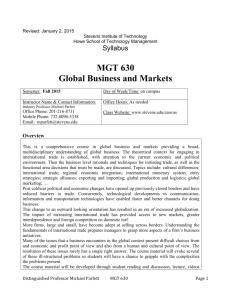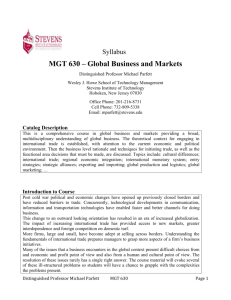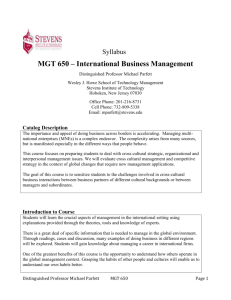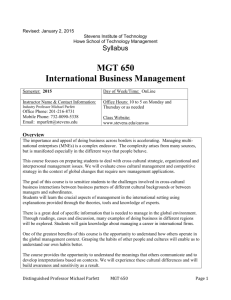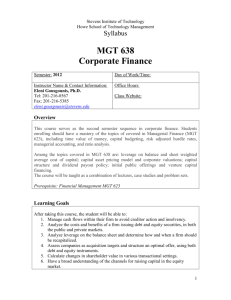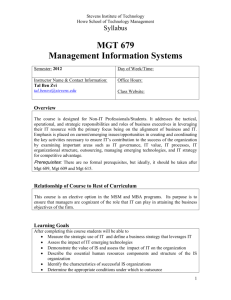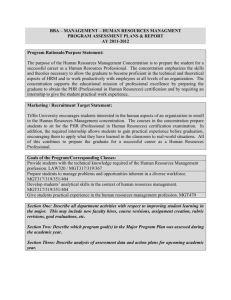Team Term Project - Stevens Institute of Technology
advertisement
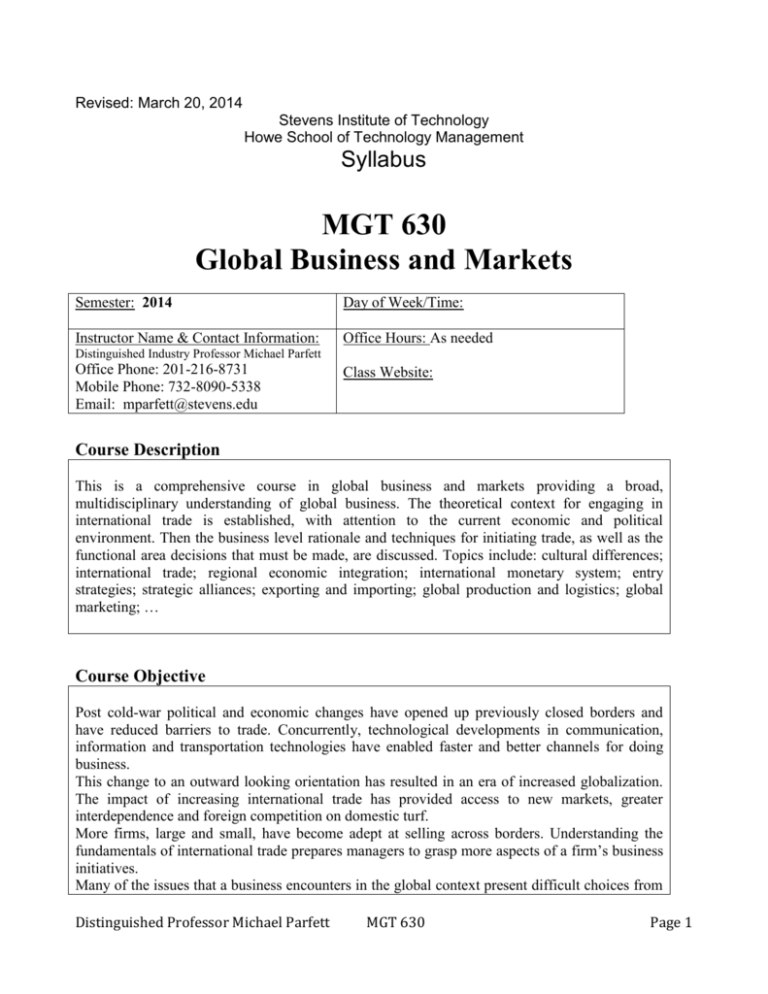
Revised: March 20, 2014 Stevens Institute of Technology Howe School of Technology Management Syllabus MGT 630 Global Business and Markets Semester: 2014 Day of Week/Time: Instructor Name & Contact Information: Office Hours: As needed Distinguished Industry Professor Michael Parfett Office Phone: 201-216-8731 Mobile Phone: 732-8090-5338 Email: mparfett@stevens.edu Class Website: Course Description This is a comprehensive course in global business and markets providing a broad, multidisciplinary understanding of global business. The theoretical context for engaging in international trade is established, with attention to the current economic and political environment. Then the business level rationale and techniques for initiating trade, as well as the functional area decisions that must be made, are discussed. Topics include: cultural differences; international trade; regional economic integration; international monetary system; entry strategies; strategic alliances; exporting and importing; global production and logistics; global marketing; … Course Objective Post cold-war political and economic changes have opened up previously closed borders and have reduced barriers to trade. Concurrently, technological developments in communication, information and transportation technologies have enabled faster and better channels for doing business. This change to an outward looking orientation has resulted in an era of increased globalization. The impact of increasing international trade has provided access to new markets, greater interdependence and foreign competition on domestic turf. More firms, large and small, have become adept at selling across borders. Understanding the fundamentals of international trade prepares managers to grasp more aspects of a firm’s business initiatives. Many of the issues that a business encounters in the global context present difficult choices from Distinguished Professor Michael Parfett MGT 630 Page 1 and economic and profit point of view and also from a human and cultural point of view. The resolution of these issues rarely has a single right answer. The course material will evoke several of these ill-structured problems so students will have a chance to grapple with the complexities the problems present. The course material will be developed through student reading and discussion, lecture, videos and student projects. The approach is both theoretical and applied, with emphasis on the real world. Additional learning objectives includes the development of: Communication Skills: This course requires students to prepare three papers that are 10 to 15 pages in length. The materials cover the culture, economics and business issues for a chosen country. The papers are presented in class and a component of the grade is based on presentation and written quality. One of the oral presentations is evaluated by faculty from the College of Arts & Letters and assessed using Learning Goal 1, Rubric 2. Team Skills: The projects in this course are done in teams. Students receive feedback on team effectiveness and participation. Analytical Problem Solving Skills: The final paper/ presentation involve an analysis of an international business problem. Working in teams, students describe the issue in detail, then analyze the current state and possible future states and finally provide a recommended direction. Global Awareness: This course is a global course, as such the entire course is focused on global topics. Course Outcomes After completing this course, students will be able to : Discuss the basics in international culture, economics, finance and operations. Have a comprehensive understanding of the global business point of view, business practices, issues and the theories that are used to explain the global context. Develop at the real world level, a detailed knowledge of a business entry strategy; and for a specific country or region fully understand an international business issue, which will integrate the various topics into the whole. Examine global issues from different viewpoints and to utilize critical thinking skills to understand the sources of the differences. Distinguished Professor Michael Parfett MGT 630 Page 2 Pedagogy The course will employ lectures, case studies, class discussions, individual assignments, and one team project made up of three parts. Students will critically evaluate and discuss global concepts. The use of Stevens online technologies (Moodle and Wimba) will supplement class discussion and external communications. Required Text(s) International Business, 9th edition, Charles W. L. Hill; Irwin McGraw-Hill, 2011. ISBN: 9780078029240. Required Readings Current event topics will be selected and discussed every week throughout the semester. Winning the $30 trillion decathlon: Going for the gold in emerging markets, McKinsey Quarterly, August 2012 Manufacturing the future: The next era of global growth and innovation, McKinsey Global Institute, McKinsey Operations Practice, November 2012 Michael Porter, The Five Competitive Forces That Shape Strategy, Harvard Business Review, January 2008. Business Cases The following business case will be individually analyzed and a detailed document written and submitted for grade: John A. Quelch, Katherine E. Jocz, Google in China A, B, C, Harvard Business School, 9-510-071 Rev: April 22, 2010; 9-510-110 Rev: July 7, 2010; 9-511-024 Rev: July 27, 2010 The following business cases represent the cases from the Hill text that will be read and discussed in class after the relevant materials are covered: Globalization of Starbucks, page 36 Japan Economic Malaise, pages 95 Wal-Mart Foreign Expansion, page 167 Global Financial crisis & Protectionism, page 245 Spain Telefonica, pages 278 Caterpillar, page 349 Evolving Strategy at IBM, page 442 A Decade of Organizational Change at Unilever, page 480 The rise of Indian Auto industry, pages 576 Microsoft in India, page 610 AstraZenena, page 638 Distinguished Professor Michael Parfett MGT 630 Page 3 Assignments Assignment Description Analysis of Case Studies One case study will be graded as an individual assignment. Analysis will include critical review of the management decisions presented in the respective case, followed by the student’s recommendations to management. Case study write-ups should be 4-7 pages in length. An exam will be given. Questions will be drawn from all course materials including lecture notes, journal articles, text book, and instructor commentary. Students will pick a country or region and identify a business issues to analyze. This will be a team project made up of three parts: 1. Cultural analysis (20%) 2. Economic analysis (20%) 3. Analysis of an international business problem (20%) Class participation and sharing of real life experiences are part of the learning process in this class. Attendance is a part of class participation and students are expected to attend all classes. 2 Mid-Term Exam 3 Team Presentations 4 Participation Total: Percentage of Grade 10% 20% 60% 10% 100% Submission of Assignments All assignments must be submitted in electronic form inside the Moodle system. Assignments submitted after the due date will be subject to a loss of grade. Distinguished Professor Michael Parfett MGT 630 Page 4 Ethical Conduct The following statement is printed in the Stevens Graduate Catalog and applies to all students taking Stevens courses, on and off campus. “Cheating during in-class tests or take-home examinations or homework is, of course, illegal and immoral. A Graduate Academic Evaluation Board exists to investigate academic improprieties, conduct hearings, and determine any necessary actions. The term ‘academic impropriety’ is meant to include, but is not limited to, cheating on homework, during in-class or take home examinations and plagiarism. “ Consequences of academic impropriety are severe, ranging from receiving an “F” in a course, to a warning from the Dean of the Graduate School, which becomes a part of the permanent student record, to expulsion. Reference: The Graduate Student Handbook, Academic Year 2003-2004 Stevens Institute of Technology, page 10. Consistent with the above statements, all homework exercises, tests and exams that are designated as individual assignments MUST contain the following signed statement before they can be accepted for grading. ____________________________________________________________________ I pledge on my honor that I have not given or received any unauthorized assistance on this assignment/examination. I further pledge that I have not copied any material from a book, article, the Internet or any other source except where I have expressly cited the source. Signature ________________ Date: _____________ Please note that assignments in this class may be submitted to www.turnitin.com, a web-based anti-plagiarism system, for an evaluation of their originality. Distinguished Professor Michael Parfett MGT 630 Page 5 Course Schedule Week 1 2 3 4 5 6 7 Topic M = module number Module 1 - Globalization M1 – Introduction and overview of class Globalization Module 2 – Similarities and Differences between countries M2 – National differences in Political economy Political economy and economic development Laws & Regulations International Legal Environ M2 – Culture Ethics in International business Module 3 – International Economic and Finance Mechanisms M3 – International Trade Theory The Political Economy of International Trade Detail Culture discussions M3 – Foreign Direct Investment Regional economic integration M3 – The foreign exchange market The international monetary system Text and Article Readings Business Cases Assignments Syllabus Hill Chapter 1 Class case discussion: Globalization of Starbucks, page 36 Hill Chapter 2, 3 Class case discussion: Japan economic malaise, page 95 Hill Chapter 4, 5 Google case due Class case discussion: Wal-Mart Foreign Expansion, page 167 Hill Chapters 6, 7 Class case discussion: Global Financial crisis & Protectionism, page 245 Cultural Team Presentations due Hill Chapters 8, 9 Class case discussion: Spain Telefonica, page 278 Hill Chapters 10, 11 Mid-term due; this will be posted in Moodle, you have a week to take the exam Class case discussion: Caterpillar, page 349 Module 4 – The strategy and Distinguished Professor Michael Parfett MGT 630 Page 6 Week Topic M = module number entry methods of international business M4 – The Strategy of International Business Entry Strategy and Strategic Alliances Text and Article Readings Business Cases Assignments Hill Chapters13 & 15 Article: Winning the $30 trillion decathlon: Going for the gold in emerging markets Class case discussion: Evolving strategy at IBM, page 442 9 Economic Discussions 10 M4 – The Organization of International Business 11 M4 – Exporting, Importing, and Countertrade Global Production, Distribution and Logistics Economic Team Presentations due Hill Chapter 14 Class case discussion: A Decade of Organizational change at Unilever, Pages 480 Hill Chapters 16 & 17 Class case discussion: Article: Manufacturing The rise of Indian auto the future: The next era of industry, page 576 global growth and innovation 8 12 Module 5 - Operations M5 – Global Marketing and R&D Hill Chapter 18 13 M5 – Global Human Resource Management Hill Chapter 19 14 Discussion of Final papers Class conclusions Distinguished Professor Michael Parfett Class case discussion: Microsoft in India, page 610 Class case discussion: AstraZenena, page 638 Final Team Presentations due MGT 630 Page 7 Team Term Project A major component of this course is the submission of a team projects. This will be a GROUP PROJECT, and each presentation is based on the prior one. You will have all of the resources to develop these presentations and have each part spelled out completely in terms of how and what to put together. The primary goals of the project are: Explore an international business issue. Gain understanding of the details of a country or region; business or industry. Make the connection between the conceptual material of the course and the way it translates to business The project requires you to develop 3 presentations. You will be assigned to a team. Once given your team you need to pick a country or region on which you will prepare the presentation. Next you need to identify a business issue that you will address. The three presentations are, in order: Cultural Analysis, Economic Analysis, and Analysis and recommend solutions to your business issue. I. Cultural Analysis Due: Week 5 The first presentation is a general survey of the country’s or regions culture. Some of the data you need is in the government publications section, the periodicals section, or the reference section of the library. Whatever is not there can be readily obtained via interlibrary loan. You are encouraged to use the Internet in your search for information in addition to commercial atlases and State Department background briefings. Part of this analysis entails developing a time-series analysis of critical political and economic events of the last sixty years or so, which define the “modern” (i.e., post-World War II) economic/political/ labor, etc. history of the chosen country. The presentation should target to be given in 30 to 45 minutes. It is expected that there will be detailed notes in the note section of power point. Areas to be addressed: II. Origins of Culture: Geography (climate, topography, flora, fauna); History; Political Economy; Social Institutions (family, religion, education, media); language Elements of Culture: Values; Rituals; symbols; beliefs; thought processes; traditions; customs; Hofstede dimensions; Trompenaars dimensions; class structure; ethnic groups; cuisine; music; sports Consequences of Culture: Consumption decisions and behaviors; business practices; management style; Political structure; Corporations; economy (from a structural perspective only, as it might relate to culture); Military; Technology Economic Analysis Due: Week 9 The second presentation covers the economy of the country. This presentation should cover the economic trends for the last 50 years; with special emphasis on the current state and projections of Distinguished Professor Michael Parfett MGT 630 Page 8 the future state. You should address the topics we discussed in class e.g., economic history; apply international trade theories to the countries; relate how politics influences the economy; government involvement; their position on foreign direct investment; trade barriers; tariffs; principle industries; export and import history; trade agreements; level of economic integration; foreign exchange market; balance of payments; currency; use of the WTO and IMF; GDP/PPP; Economic outlook and challenges; consumer confidence; doing business in the country … This presentation should target to be given in 30 to 45 minutes. III. Analysis of the business issue and Alternative Solutions Due: Week 13/14 The third presentation involves analyzing the business issue you have chosen and prepare a though evaluation with proposed solutions. You need first to define the business issue in detail then analysis the past and current state and propose the future state. There should be several alternatives discussed with pro’s and con’s for each and then the selected solution discussed in detail. This presentation should be targeted to be given in 30 to 45 minutes. Assignment guidance: You should use and sight references. Good sources: academic journals, government or trade organization data, textbooks, company information, country information. See the links for information sources for paper below. Use footnotes or endnotes and show your sources. A fair quality paper tells a story and reports on events. A good quality paper uses greater depth of information from different sources, shows greater detail and connection of theory to the situation being studied. An outstanding quality paper uses detail, theory and contracts in information to show thoughtful probing and analytic understanding of the topic. Possible topics: 1. Emerging markets (BRIC – Brazil, Russia, India, China) – 75% of the growth in the last 2 years has come from these counties. Can this be sustained? How? What does this mean for the rest of the world, especially the United States and the EU. 2. Is Singapore the new financial center? What does this mean for the rest of the world? 3. What is Japan’s role in the current and future global finance markets? 4. What does the mid-east’s unrests mean for the rest of the world? 5. What was/is the impact of the tornado and nuclear accident on the Japanese economic? How did it affect the rest of the world? E.g., auto industry … 6. Economic, Political, Social crisis in Egypt. What is Egypt’s future? How will infect the EU? 7. Prepare a case study of a firm’s success (or failure) story in international business 8. What is the future of the European Union (EU)? What might be the impact on the countries within the EU? What might be the impact on counties outside the EU? Will the Euro survive? Should the EU let Greece fail? 9. How will Brazil handle inflation? 10. What will be China’s position on international trade be? 11. Should Turkey enter the EU? Distinguished Professor Michael Parfett MGT 630 Page 9 LINKS FOR INFORMATION SOURCES FOR PAPER CIA World Factbook Export Import Bank International Monetary Fund (IMF) Organization for Economic Cooperation and Development (OECD) United Nations U.S. Agency for International Development (USAID) U.S. State Department Background Notes World Bank World Trade Organization (WTO) COUNTRY REGIONS for PROJECT 1. 2. 3. 4. 5. 6. 7. Regional Groupings North America: Bermuda, Canada, Mexico, The Bahamas, United States ** Central America: Guatemala, Belize, Honduras, Nicaragua, Costa Rica, Panama, El Salvador The Caribbean Basin: Cuba, Dominican Republic, Jamaica, Haiti, Cayman Islands, Martinique South America: Venezuela, Guyana, Surinam, French Guyana, Colombia, Ecuador, Peru, Brazil, Bolivia, Paraguay, Uruguay, Chile, Argentina Western Europe: Ireland, United Kingdom, France, Switzerland, Portugal, Spain, Netherlands, Belgium, German)’, Austria, Norway, Sweden, Denmark, Italy, Luxembourg Central and Eastern Europe: Poland, Czech Republic, Slovakia, Hungary, Romania, Ukraine, Moldova, Belarus, Russia, Estonia, Latvia, Lithuania; The Balkans and South-Eastern Europe: Croatia, Slovenia, Bosnia, Serbia, Macedonia, Greece, Turkey, Distinguished Professor Michael Parfett MGT 630 Page 10 Bulgaria, Albania; 8. Central Asia: Kazakhstan, Kyrgyzstan, Tajikistan, Uzbekistan, Turkmenistan, Azerbaijan, Armenia, Georgia; 9. Middle East: Saudi Arabia, Syria, Iraq, Iran, Jordan, Israel, Oman, Yemen, United Arab Emirates, Kuwait; 10. South Asia: India, Pakistan, Thailand, Bangladesh, Myanmar, Laos, Viet Nam, Cambodia, Nepal, Sri Lanka; 11. Oceania: Malaysia, Singapore, Indonesia, Philippines, Papua New Guinea, Australia, New Zealand, Brunei; 12. North Asia: China, Mongolia, North Korea, South Korea, Taiwan, Hong Kong, Japan; 13. Northern Third of Africa: Egypt, Somalia, Ethiopia, Sudan, Libya, Tunisia, Algeria, Morocco, Sudan, Mali, Mauritania, Western Sahara; 14. Western Africa: Senegal, Gambia, Guinea, Liberia, Cote d’Ivoire, Ghana, Nigeria, Cameroon, Central African Republic, Sierra Leone, Togo, Benin, Burkina Faso; 15. Central Africa: Chad, Niger, Central African Republic, Democratic Republic of the Congo, Uganda, Gabon, Congo Republic, 16. Southern and Southeastern Africa: Kenya, Tanzania, Angola, Zambia, Malawi, Zimbabwe, Botswana, Namibia, Mozambique, South Africa. ** Do not chose the United States for this project Business Cases: We will have group discussions in class on several of the cases included in your text. They are listed in the course schedule above. Additionally, there will be detailed business cases assigned as individual assignments that will be graded. These write-ups will involve a 3-5 page memo (typed, double-spaced, font no smaller than 11 pt., 1-inch margins all around); Acceptable fonts are Times New Roman, and Arial). You need to address each question thoroughly. In addition, focus on the following three factors: (1) statement of the problem(s) or decision(s) to be made; (2) description of your decisions or recommendations; (3) supporting logic and analyses. The questions associated with each case should help you focus your analyses. These questions appear at the end of each case. You will submit each memo responding to the assignment in Moodle. Each written memo will be evaluated using the following criteria: a. Quality and relevance of the information included. b. Was the analysis thorough given the page limit? How practical are the recommendations? Were all the questions answered properly? c. Grammar, spelling, and readability. Note on Case Analysis Cases are not like exams. You must apply information from many sources (text, lecture notes, the case itself, and outside references) to develop a recommendation that is both conceptually appropriate and managerially feasible. Make sure that you address all the questions in your analysis. You should answer each question individually as well as the analysis discussed above. Approach the case as an outside consultant brought in by a senior manager or executive. Pay particular attention to the who, when, how, and where, dimensions of the recommendations, as well as the what. Do not dump the problem back in your client’s lap with a recommendation like Distinguished Professor Michael Parfett MGT 630 Page 11 “You must develop a new mission statement to better define strategic opportunities.” Give them a sample mission statement so they can see what you are recommending. Present evidence supporting the recommended course of action. Your opinions do not constitute evidence; information does. Information consists of more than simply restating case exhibit data. For example, rework case data into ratios or indexes that capture a trend. Do not just report isolated numbers, “Dunfey Hotel’s first quarter market share dropped from 27% to 23%, while Sheraton’s share improved from 39% to 44% in the same period.” To communicate effectively remember your goal is to persuade a senior manager to implement your recommendation. Get to the point, write sparingly and convey as much relevant supporting information as possible. Avoid flowery language, slang, and colloquialisms. Distinguished Professor Michael Parfett MGT 630 Page 12
